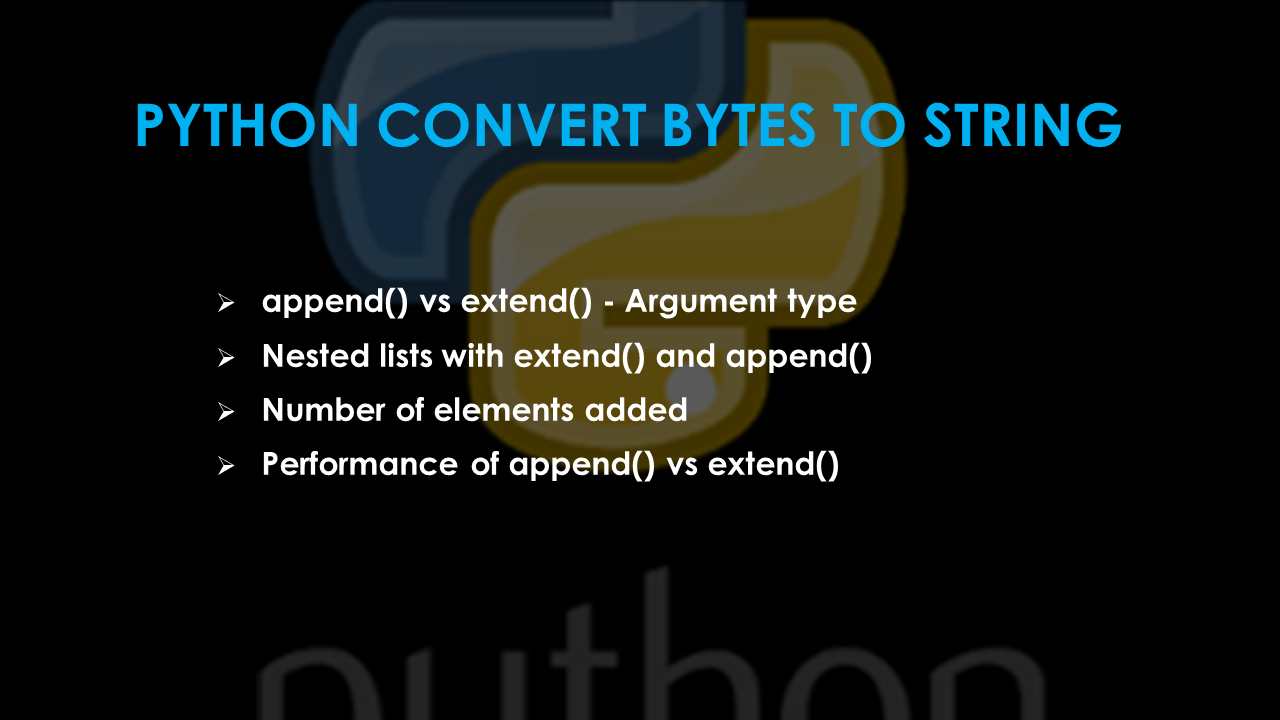Python List append() vs extend(): Key Differences Explained
Learn the key differences between Python's list methods 'append' and 'extend' and how they impact your data manipulation.
Learn the key differences between Python's list methods 'append' and 'extend' and how they impact your data manipulation.
In Python, you can add elements to the end of a list using the append() and extend() methods. However, they differ in how they add these elements.
In Python, both append() and extend() are used to add elements to the end of a list, but they do so in different ways.
append() adds a single element to the end of a list. This element can be a single value, like a number or a string, or it can be a more complex object, like another list. When you use append() with another list, the entire list is added as a single element, creating a nested list.
extend(), on the other hand, adds multiple elements to the end of a list. It takes an iterable object, such as another list, tuple, or string, and adds each element of that iterable to the original list individually.
Here's a simple way to remember the difference:
append() when you want to add one thing to the end of a list.extend() when you want to add multiple things to the end of a list.This code demonstrates the difference between the append() and extend() methods in Python lists. The append() method adds an entire object to the end of a list, while the extend() method iterates over an iterable (like another list or a string) and adds each element to the end of the list individually.
# Using append()
list1 = [1, 2, 3]
list1.append(4)
print(list1) # Output: [1, 2, 3, 4]
list2 = [1, 2, 3]
list2.append([4, 5])
print(list2) # Output: [1, 2, 3, [4, 5]]
# Using extend()
list3 = [1, 2, 3]
list3.extend([4, 5])
print(list3) # Output: [1, 2, 3, 4, 5]
list4 = [1, 2, 3]
list4.extend("abc")
print(list4) # Output: [1, 2, 3, 'a', 'b', 'c'] Explanation:
append() Examples:
4 to list1.[4, 5] to list2. Notice how it's added as a single element, creating a nested list.extend() Examples:
list3 with the elements of the list [4, 5], adding each element individually.list4 with the string "abc". Since strings are iterable, each character is added separately.extend() is generally faster than using repeated append() calls in a loop when adding multiple elements.extend() using list concatenation (+ operator) or slicing, but extend() is often more readable and efficient.append() in loops.append(): Useful for building a list element by element, especially when you need to add items conditionally within a loop.extend(): Ideal for combining lists, adding elements from a tuple or string to a list, or quickly populating a list with multiple values from an iterable.append() and extend() are found in other programming languages, often with the same or similar method names. Understanding these methods in Python can be helpful when working with lists or arrays in other languages.| Method | Description | Input | Result |
|---|---|---|---|
append() |
Adds a single element to the end of a list. | Single element (any type) | Adds the element as a single item to the list. |
extend() |
Adds multiple elements to the end of a list. | Iterable (list, tuple, string) | Adds each element of the iterable individually to the list. |
Choosing between append() and extend() depends on your desired outcome: add a single element as-is with append(), or add elements individually from an iterable with extend(). Understanding this distinction helps you manipulate lists effectively in Python.
 append() and extend() in Python - GeeksforGeeks | A Computer Science portal for geeks. It contains well written, well thought and well explained computer science and programming articles, quizzes and practice/competitive programming/company interview Questions.
append() and extend() in Python - GeeksforGeeks | A Computer Science portal for geeks. It contains well written, well thought and well explained computer science and programming articles, quizzes and practice/competitive programming/company interview Questions. Difference Between Append and Extend in Python List Methods ... | Learn about differences between extend and append list methods in Python on Scaler Topics.
Difference Between Append and Extend in Python List Methods ... | Learn about differences between extend and append list methods in Python on Scaler Topics. Python List Append VS Python List Extend – The Difference ... | 🔹 Welcome If you want to learn how to work with .append() and .extend() and understand their differences, then you have come to the right place. They are powerful list methods that you will definitely use in your Python projects. In this article, y...
Python List Append VS Python List Extend – The Difference ... | 🔹 Welcome If you want to learn how to work with .append() and .extend() and understand their differences, then you have come to the right place. They are powerful list methods that you will definitely use in your Python projects. In this article, y... Difference Between append and extend in Python - Shiksha Online | Jun 14, 2024 ... Append function in Python adds a single element to the end of the list, whereas the extend function adds multiple elements (from an iterable) to ...
Difference Between append and extend in Python - Shiksha Online | Jun 14, 2024 ... Append function in Python adds a single element to the end of the list, whereas the extend function adds multiple elements (from an iterable) to ... Using square brackets: Extend() vs Append() (Example) | Treehouse ... | Kristian Woods is having issues with: Why when you use square brackets in append() - it creates a list inside a list?
Using square brackets: Extend() vs Append() (Example) | Treehouse ... | Kristian Woods is having issues with: Why when you use square brackets in append() - it creates a list inside a list? Append vs. extend in Python | Sentry | The Problem What is the difference between Python's list methods append() and extend() ? The Solution The append() method is used to add an item to the end…
Append vs. extend in Python | Sentry | The Problem What is the difference between Python's list methods append() and extend() ? The Solution The append() method is used to add an item to the end… 5. Data Structures — Python 3.12.7 documentation | This chapter describes some things you’ve learned about already in more detail, and adds some new things as well. More on Lists: The list data type has some more methods. Here are all of the method...
5. Data Structures — Python 3.12.7 documentation | This chapter describes some things you’ve learned about already in more detail, and adds some new things as well. More on Lists: The list data type has some more methods. Here are all of the method... Python Difference between List append() vs extend() - Spark By ... | What is the difference between list append() vs extend() methods in Python? The append() and extend() methods are two commonly used methods to add
Python Difference between List append() vs extend() - Spark By ... | What is the difference between list append() vs extend() methods in Python? The append() and extend() methods are two commonly used methods to add